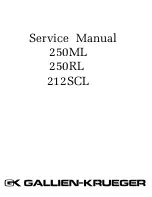
52-0031-0100 EP04-05-05 DPA2500T DPA4000T Anglès.doc 2 of 2
When the MosFET's Id level rises above a certain level, transistor Q119 (controlling transistor) conducts and
decreases the BF transistor's loading resistance, thus reducing also their gate-source voltage and, finally, lowering
the Id current value. This system is helped by a delayed performance, due to the associated circuitry to Q145 and
C174. This capacitor starts to charge when a current level above the allowed value is detected, and the protection
starts. The greater is the capacitor's charge level, the higher is also the voltage applied to Q119 controlling
transistor's base, increasing its conduction and, consequently, reducing the gate-source voltage and thus the Id
current value. This system uses a feedback network. The delay used is necessary to avoid clipping the processed
signal's dynamic range, with should result in the typical clipping noise. In the negative branch, the protection
circuitry is associated to control transistor Q120.
In case the overcurrent is not occasional, and persists, after a period of time between 4 and 10 seconds
(determined by R142 and C124), the system switches back to Stand-by mode, due to a system-reset. This is done
by an optocoupler (IC113) associated to the negative branch protection circuitry. When protections get activated,
IC113 gradually charges C124 until a 40106-type Schmidt trigger gate switches over. If the problem persists, this
cycle is repeated.
STANDBY CIRCUITRY. This circuit maintains the Output shutdown relay closed for about 10 seconds, and thus
annulated any current through the MosFET's during this period, just until the whole system's power supply voltage
reaches its stable level. By this system, we avoid to hear through the loudspeakers any possible annoying noise
proceeding from the system's start-up.
This delay time is achieved by using a RC cell, where R135=287K and C119=47µF/50V. As this cell charges, its
voltage increases until reaching the 40106-type Schmidt trigger (IC108) switching value; at this point, the relay
opens and the amplifier starts to function normally.
The discharge or reset of capacitor C119=47µF can be done by cutting off the power supply, or by triggering the
Thermal or other protections. During a short period of time, BC817-type transistor Q102 acts like a switch, shunting
two 75
Ω
resistors to C119.
Moreover, the amplifier includes some other additional features, like:
- Volume control by a VCA system.
- An ANTICLIP system.
- A Temperature control system.
THE ANTICLIP SYSTEM. When the amplifier reaches clipping levels, the operational amplifier looses control on
the system's performance and at its output some ±Vcc voltage peaking pulses may appear, proceeding from its
power supply. This peaking pulses are used to be rectified and sent to an optocoupler (IC111), with varies the
system's VCA control voltage as a function of those pulse's amplitude, creating a negative feedback with should
pull back the system into stable functioning area.
The Temperature control system has three main functions:
- Controlling the cooling fan speed, as it is a function of the measured temperature. The fan's operation voltage
range is 7 to 14 Volts.
- Suspending the amplifier's functioning when the temperature exceeds 92ºC
- Reducing the amount of power output, depending on the module's temperature (as it rises above 85ºC) and on
the main power supply's transformer (above 120ºC).
The temperature control system consists on two LM35D-type IC's, with act like a thermal probe; one is placed on
the amplifier's heat sink, and the other is placed into the main power supply transformer's core. Moreover, three
amplifiers, a comparator for the thermal probe and a 7805-type IC to feed the cooling fan are used.
The first amplifier (1/4 IC114) acts on the cooling fan speed control. The second amplifier (1/4 IC114) modifies the
VCA gain control, in order to reduce the system's gain if the temperature rises above 85ºC. The third amplifier (1/4
IC114) modifies the VCA gain control, in order to reduce the system's gain if the temperature rises above 120ºC.
The comparator (1/4 IC114) is responsible for the output shutdown relay performance, in order to close it as the
temperature reaches 92ºC, and thus cutting of the amplifier's MosFETs bias current. As this happens, the signal
output of the whole unit is cutted off.
Содержание DPA2500T
Страница 1: ...DPA2500T DPA4000T SERVICE MANUAL ...
Страница 3: ......
Страница 6: ......
Страница 7: ......
Страница 8: ......
Страница 9: ......
Страница 10: ......
Страница 11: ......
Страница 12: ......
Страница 13: ......
Страница 16: ......
Страница 17: ......
Страница 19: ......
Страница 20: ......
Страница 22: ......
Страница 23: ......
Страница 25: ......
Страница 26: ......
Страница 34: ......
Страница 35: ......
Страница 37: ......
Страница 39: ......
Страница 40: ......
Страница 41: ......
Страница 42: ......
Страница 54: ......
Страница 55: ......
Страница 56: ......
Страница 57: ......






































